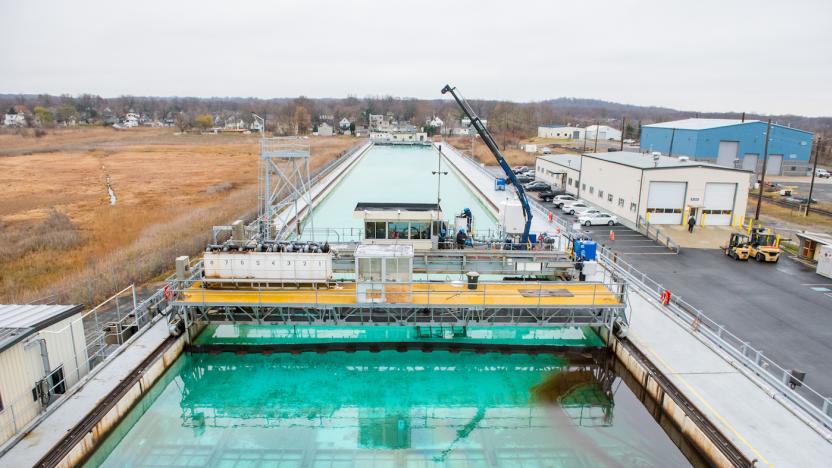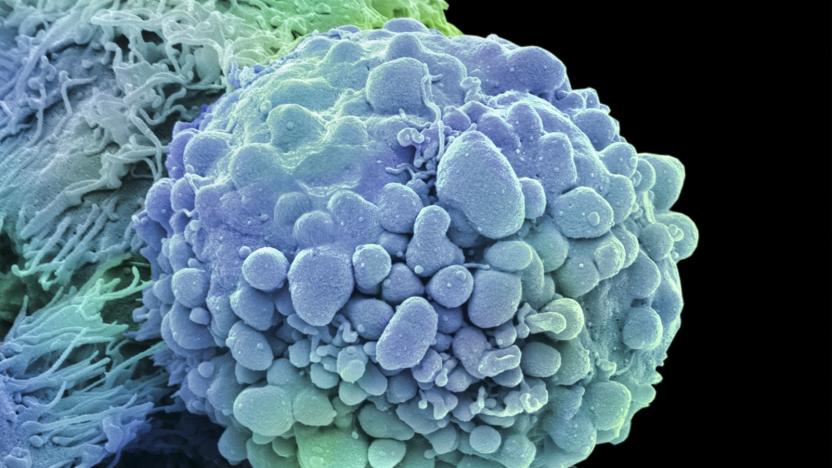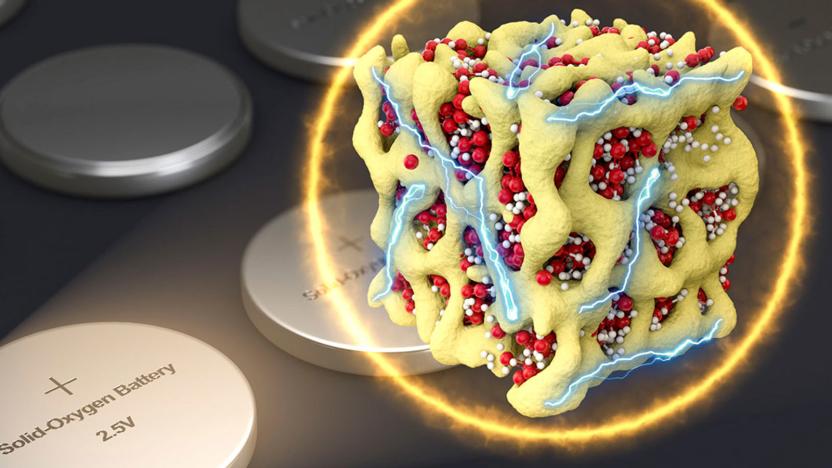ArgonneNationalLaboratory
Latest

'Oleo Sponge' may be the key to cleaning up after oil spills
Cleaning up after an oil spill isn't an easy job. Just ask Exxon Mobil, or, for a more recent example, BP. Current clean-up methods include skimming it of a body off water's surface or burning it. Neither are ideal for a few reasons, but beyond impacting the environment even further, they don't account for the sludge that's trapped below the waves. That's where the Department of Energy's Oleo Sponge comes in.

NVIDIA helps the US build an AI for cancer research
Microsoft isn't the only big-name tech company using AI to fight cancer. NVIDIA is partnering with the US Department of Energy and the National Cancer Institute to develop CANDLE (Cancer Distributed Learning Environment), an AI-based "common discovery platform" that aims for 10 times faster cancer research on modern supercomputers with graphics processors. The hardware promises to rapidly accelerate neural networks that can both spot crucial data and speed up simulations.

Lithium-oxygen battery promises lighter electric cars
Lithium-air batteries are supposed to lead to lighter, longer-ranged electric cars thanks to their high power-to-weight output, but they have some showstopping flaws: they not only degrade rapidly, but waste a lot of energy input as heat. Neither is exactly ideal in a vehicle that's expected to last you several years and charge quickly. Scientists at MIT, Argonne National Laboratory and Peking University might have found a better way, though. They've engineered a lithium-oxygen battery that offers the light weight of lithium-air without its drawbacks.

Scientists create quantum entanglement at room temperature
Quantum entanglement, where two particles are inextricably linked, is a real thing. However, creating that odd behavior has been extremely difficult so far -- you have to cool things down to near absolute zero to pull it off on a significant scale. Or rather, you did. Researchers have successfully produced macro-scale quantum entanglement at room temperature through the one-two combo of an infrared laser (which aligned magnetic states) and electromagnetic pulses (for the actual entanglement). The experiment only included enough electrons and nuclei to fill the space of a blood cell, but that still amounts to linking "thousands" of particles.

Chicago is getting lamp posts that count people and track pollution
Apparently, Chicago is becoming even more like its Watch Dogs doppelganger than we first thought. Researchers are deploying networked, sensor-equipped lamp posts from this July onward to learn how they could help urban planning and safety. They'll collect environmental data like air quality, noise levels and wind, and they'll also measure foot traffic by counting the number of passing cellphones. If the project takes off, Chicago officials could easily tell if air pollution is on the rise, or if a narrow sidewalk is creating a choke point.

Microbial music: Using sound to represent data from the deep blue sea
Science and music, many would say opposite sides of the same coin. Unless you're DOE biologist Peter Larsen at the Argonne National Laboratory, who would probably argue your legal tender has been double-headed all along. While Larsen is more likely to be studying the intricacies of microbes than Miles Davis, his latest work puts the two of them closer than ever before. Faced with the task of studying vast amounts of microbial data gathered from the English Channel, the biologist explored alternative ways of making sense of it all. While he could have made a spiffy set of charts, Larsen claims that there are certain parameters, like sunlight and temperature, that give the data a structure that lends itself to musical representation. While classical music might seem the typical choice, due to the irregular nature of the data, the result is more free-form jazz, yet still surprisingly musical. If you were wondering if there is something particularly groovy about the microbes in the English Channel, there isn't. Larsen and his colleagues used a similar idea in previous work looking at the relationship between a plant and a fungus. This isn't the first time data has been "sonified," but these processes that might initially seem to have no relation to music, rhythm and melody, actually highlight the patterns in natural phenomena. Want to get down to the microbial beat? You can hear a sample at the more coverage link. [Image Credit: Argonne National Laboratory]

IBM's Mira supercomputer tasked with simulating an entire universe in a fortnight
A universe that only exists in the mind of a supercomputer sounds a little far fetched, but one is going to come to live at the Argonne National Laboratory in October. A team of cosmologists is using IBM's Blue Gene/Q "Mira" supercomputer, the third fastest in the world, to run a simulation through the first 13 billion years after the big bang. It'll work by tracking the movement of trillions of particles as they collide and interact with each other, forming structures that could then transform into galaxies. As the project's only scheduled to last a fortnight, we're hoping it doesn't create any sentient characters clamoring for extra life, we've seen Blade Runner enough times to know it won't end well.

New metal mix could lead to cheap, plentiful sodium-ion batteries in gadgets
Lithium batteries very frequently power our gadgets, but the material itself isn't common and, by extension, isn't cheap. Researchers at the Tokyo University of Science aim to solve that through sodium-ion batteries using a new electrode material. By mixing together oxides of iron, manganese and sodium, Shinichi Komaba and team have managed to get a sodium battery's electrode holding a charge closer to that of a lithium-ion battery while using a much more abundant material. Having just 30 total charges means this simplest form of sodium-ion battery technology could be years away from finding a home in your next smartphone or EV, although it's not the only option. Argonne National Laboratory's Chris Johnson has co-developed a more exotic vanadium pentoxide electrode that could produce 200 charges while keeping the battery itself made out of an ingredient you more often find in your table salt than your mobile gear. [Image credit: Hi-Res Images of Chemical Elements]

New nanotube battery technology leads to blisteringly fast recharges, improved safety features
Some day, your restroom break may be enough time to charge your [insert nifty gadget here] halfway. A group of researchers at the Department of Energy's Argonne National Laboratory has discovered that nanotubes composed of titanium dioxide can switch their phase as a battery is cycled, gradually boosting their operational capacity. The upshot: laboratory tests showed that new batteries produced with this material could be rejuvenated to 50 percent of their maximum charge in less than 30 seconds. This was accomplished by replacing conventional graphite anodes with titanium nanotube andodes. Following the experiment, lead researcher Tijana Rajh and her colleagues noted that as the battery cycled through several charges and discharges, its internal structure began to orient itself in a way that dramatically improved the battery's performance. Furthermore, using anodes composed of titanium dioxide instead of graphite could improve the reliability and safety of lithium-ion batteries and help avoid scenarios in which the lithium can deposit on the graphite anodes, causing a dangerous chain reaction known as "thermal runaway." Copious amounts of related technobabble can be found in the links below, and there's a video just past the break, too.

IBM's Mira supercomputer does ten petaflops with ease, inches us closer to exascale-class computing
Say hello to the Blue Gene/Q, or if you're looking for something a bit less intimidating, "Mira." That's IBM's latest and greatest concoction, a ten-petaflop supercomputer capable of running programs at ten quadrillion calculations a second. Hard to say who'd win between Mira and Watson, of course, but there's absolutely no question who'd come out on top if Mira were pitted against her predecessor Intrepid (hint: Mira's 20x faster). To put this all in perspective, IBM's chiming in with this: "If every man, woman and child in the United States performed one calculation each second, it would take them almost a year to do as many calculations as Mira will do in one second." Mira's next stop is at the US Department of Energy's Argonne National Laboratory, where it'll be used to tackle 16 projects in particular that were drawn from a pool of proposals to gain access to her capabilities. We're told that these include a range of initiatives -- from reducing energy inefficiencies in transportation and developing advanced engine designs to spurring advances in energy technologies -- and in time, it could lead to exascale-class computers "that will be faster than petascale-class computers by a factor of a thousand." And here we are getting excited about a 5GHz Core i7.

GM sheds a little more light on next-gen Volts and next-gen battery packs
Being locked in a car with General Motors representatives for the better part of a day gave us plenty of time to talk about... well, just about everything. On the list of topics was discussions about what's next for the company in the Volt space. Back then they said there'd be more of the things coming, and now they're giving a little more information, confirming that a hatchback and crossover SUV will be similarly electrified sometime within the next three years. A little further down the road GM will roll out its next-generation battery technology, currently under development at Argonne National Laboratories. These mixed-metal oxide batteries add nickel and cobalt to the battery cathode mix, while the cells themselves remain lithium-ion. This is said to double capacity of any given battery, meaning the Volt could go just as far with half the weight. Or, you know, twice as far with the same weight. Isn't math fun? Update: Well, Autoweek is saying it's going to be a minivan, not a crossover -- though honestly there's not much difference there.

Bacteria taught to spin microscopic gears right round, could make for better solar panels
With a name like Bacillus subtilis and a size of five microns you probably wouldn't expect much in the way of heavy lifting, but don't let first impressions fool you. This tiny organism has been taught by scientists at Argonne National Laboratory to spin little gears that weigh one million times more than the bacteria themselves -- that'd be like you lifting both an original Xbox and a PS3 at the same time! Applications are, apparently, endless, but the one that caught our eye involves photovoltaics able to "snag lots of photons from the sun." You know what that means: more juice for your Prius so you can crank that Dead or Alive CD guilt-free.






